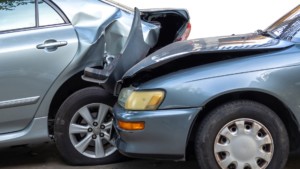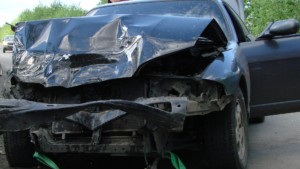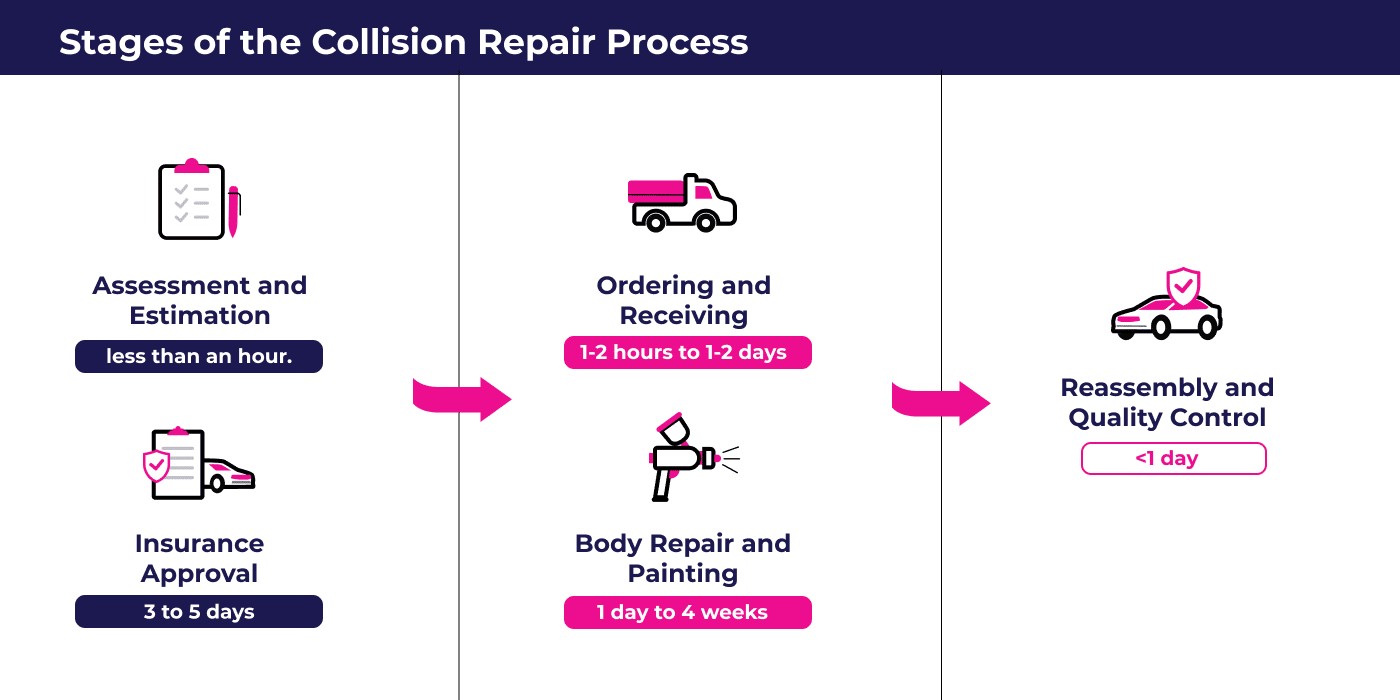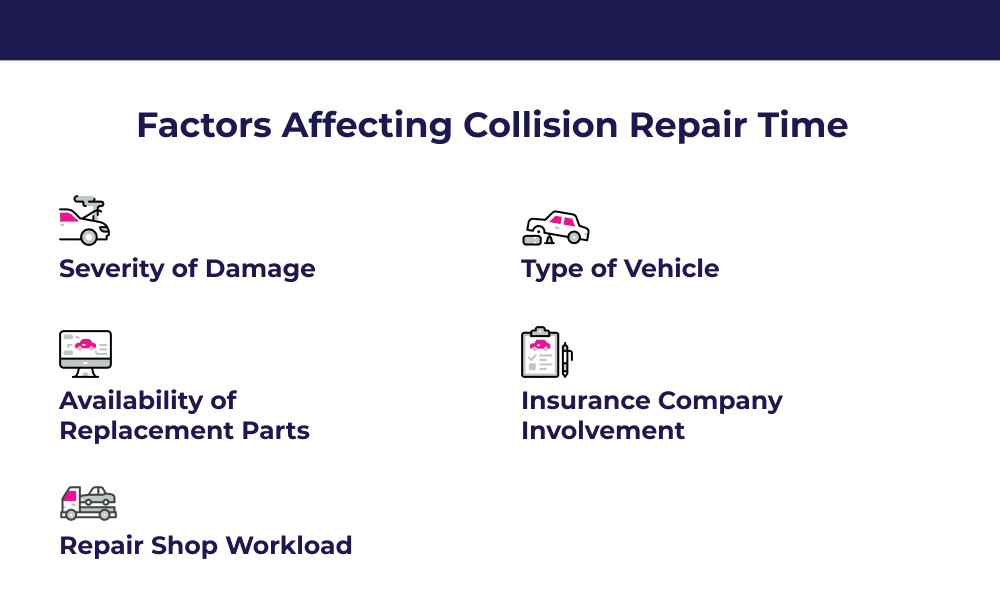How Quickly Do You Need The Vehicle Repaired? Repair time depends on various factors, but CAR-TOOL.EDU.VN helps you understand the process and find the best solutions for fast, reliable auto repairs and the necessary tools. Explore estimated repair times, stages, and influencing factors for efficient vehicle restoration with automotive tools and parts.
Contents
- 1. Understanding the Urgency: Defining Your Repair Timeline
- 1.1 Assessing Your Immediate Needs
- 1.2 Balancing Speed and Quality
- 1.3 Setting Realistic Expectations
- 2. Decoding the Average Collision Repair Time: A Comprehensive Guide
- 2.1 Minor Collision Repair: Quick Fixes for Minor Damages
- 2.1.1 Common Examples of Minor Collision Repair
- 2.2 Major Collision Repair: Addressing Complex Structural Issues
- 2.2.1 Common Examples of Major Collision Repair
- 2.3 Severe Collision Damage: Extensive Repairs and Restoration
- 2.3.1 Common Examples of Severe Collision Damage
- 2.4 Paintless Dent Repair (PDR): A Quick and Efficient Solution
- 2.5 Bumper, Fender, and Door Repairs: Common Body Work
- 2.6 Glass Replacement: A Relatively Quick Process
- 2.7 Suspension Repair: Ensuring Vehicle Stability
- 2.8 Frame Straightening: A Specialized Process
- 2.9 Paint Repair: Restoring the Vehicle’s Finish
- 2.10 Airbag Replacement: A Critical Safety Repair
- 2.11 Engine Repair/Replacement: A Lengthier Process
- 2.12 Full Vehicle Restoration: A Comprehensive Undertaking
- 3. Collision Repair Process Stages: From Assessment to Completion
- 3.1 Assessment and Estimation: The First Crucial Step
- 3.2 Insurance Approval: Navigating the Claim Process
- 3.3 Ordering and Receiving Parts: A Potential Delay
- 3.4 Body Repair and Painting: Restoring the Vehicle’s Structure and Appearance
- 3.5 Reassembly and Quality Control: Ensuring Safety and Performance
- 3.6 Additional Factors to Consider: Hidden Damage and Specialized Repairs
- 4. Key Factors Influencing Collision Repair Time: A Detailed Analysis
- 4.1 Severity of Damage: A Primary Determinant
- 4.2 Availability of Replacement Parts: A Potential Bottleneck
- 4.3 Type of Vehicle: Impact on Parts and Expertise
- 4.4 Insurance Company Involvement: A Necessary Process
- 4.5 Repair Shop Workload: An Overlooked Factor
- 5. Optimizing Repair Speed: Tips for a Quicker Turnaround
- 5.1 Choose a Reputable Repair Shop
- 5.2 Communicate Clearly and Proactively
- 5.3 Expedite Parts Ordering
- 5.4 Manage Insurance Claims Efficiently
- 5.5 Be Flexible with Scheduling
- 6. The Role of Automotive Tools in Expediting Repairs
- 6.1 Diagnostic Tools
- 6.2 Specialized Repair Tools
- 6.3 Welding and Cutting Equipment
- 6.4 Paint Matching Technology
- 6.5 Lifting Equipment
- 7. Understanding OEM vs. Aftermarket Parts: Impact on Repair Time
- 7.1 OEM Parts
- 7.2 Aftermarket Parts
- 7.3 Impact on Repair Time
- 8. Cost vs. Time: Finding the Right Balance
- 8.1 Prioritizing Speed
- 8.2 Prioritizing Cost
- 8.3 Finding the Optimal Balance
- 9. The Future of Collision Repair: Innovations and Trends
- 9.1 Advanced Materials
- 9.2 Autonomous Driving Technology
- 9.3 3D Printing
- 9.4 Virtual Reality (VR) Training
- 10. FAQs: Addressing Common Questions About Collision Repair Time
- 10.1 What do I use for transportation while my car is in the shop?
- 10.2 Do you offer an automotive repair warranty?
- 10.3 How long does it take to fix a front-end collision vs rear-end collision?
- 10.4 When is my car considered a total loss?
- 10.5 What do I do if it’s taking much longer than originally estimated?
- 10.6 How much does collision repair cost?
1. Understanding the Urgency: Defining Your Repair Timeline
How quickly do you need the vehicle repaired? This question is paramount when your car is in the shop. The urgency of getting your car back on the road often dictates the repair approach and the resources you’ll need. Whether it’s for daily commuting, business needs, or family obligations, understanding your required turnaround time is the first step in navigating the repair process. This involves assessing the severity of the damage, considering the availability of parts, and aligning your expectations with what’s realistically achievable. At CAR-TOOL.EDU.VN, we aim to provide insights that help you make informed decisions, balancing speed with quality and cost-effectiveness.
1.1 Assessing Your Immediate Needs
Before even contacting a repair shop, take a moment to evaluate why you need your car back quickly. Is it essential for your daily commute, or do you have some flexibility? Knowing this will help you communicate your needs effectively to the repair shop. If you need your car urgently, you might prioritize shops that offer faster turnaround times or express services, even if they come at a slightly higher cost.
1.2 Balancing Speed and Quality
While speed is often a priority, it’s crucial not to compromise on the quality of the repair. A rushed job might lead to overlooking crucial details, potentially causing further issues down the line. Therefore, it’s about finding a balance. Look for repair shops that are known for their efficiency but also have a reputation for thoroughness and attention to detail.
1.3 Setting Realistic Expectations
It’s essential to have realistic expectations about how quickly your car can be repaired. Complex repairs, especially those involving rare parts or extensive body work, will naturally take longer. Discuss the expected timeline with the repair shop and understand the factors that might influence it. This will help you plan accordingly and avoid unnecessary stress.
2. Decoding the Average Collision Repair Time: A Comprehensive Guide
“How quickly do you need the vehicle repaired?” depends on the type and extent of the damage. Average auto body repair times can range from a few hours to several weeks. CAR-TOOL.EDU.VN offers this comprehensive breakdown to help you estimate the repair duration for your specific situation.
| Type of Collision Repair | Average Time to Fix |
|---|---|
| Minor Collision Repair | 1-3 days |
| Major Collision Repair | 1 to 3 weeks |
| Paintless Dent Repair | 1-2 days |
| Bumper Repair/Replacement | 1-3 days |
| Fender Repair/Replacement | 1-4 days |
| Door Repair/Replacement | 2-4 days |
| Glass Replacement | 1-2 days |
| Suspension Repair | 2-3 days |
| Frame Straightening | 4 days – 2 weeks |
| Paint Repair (minor) | 2-4 days |
| Paint Repair (major) | 1-2 weeks |
| Airbag Replacement | 2-5 days |
| Engine Repair/Replacement | 1-4 weeks |
| Full Vehicle Restoration | 4-8 weeks or longer |
This table provides a general overview. The actual time can vary based on factors discussed later in this article.
2.1 Minor Collision Repair: Quick Fixes for Minor Damages
Minor collision repairs typically address cosmetic issues like small dents, scratches, or minor bumper damage. These repairs are generally quick, often taking just 1 to 3 days. Because they don’t affect the vehicle’s core structure, they require less labor and can be completed efficiently with the right tools and parts.
2.1.1 Common Examples of Minor Collision Repair
- Small Dents: Dents from shopping carts or minor impacts are usually straightforward to fix.
- Scratches: Surface scratches from tree branches or road debris can often be buffed out or repainted quickly.
- Minor Bumper Damage: Small cracks or scuffs on the bumper can be repaired or replaced without significant downtime.
 car with a dent from a shopping cart
car with a dent from a shopping cart
2.2 Major Collision Repair: Addressing Complex Structural Issues
Major collision repairs involve more significant damage, such as frame damage, mechanical problems, or airbag replacements. These repairs typically take 1 to 3 weeks due to the complexity of the work and the potential need to order specialized parts.
2.2.1 Common Examples of Major Collision Repair
- Frame Damage: Damage to the vehicle’s frame requires specialized equipment and expertise to straighten and repair.
- Airbag Replacement: Replacing airbags involves careful calibration and system checks to ensure proper functionality.
- Extensive Body Work: Repairs involving multiple panels, structural components, or significant damage to the vehicle’s integrity.
 car with rear end damage, including a crushed trunk and a damaged bumper
car with rear end damage, including a crushed trunk and a damaged bumper
2.3 Severe Collision Damage: Extensive Repairs and Restoration
In cases of severe damage, repairs can extend beyond 3 weeks. This often involves extensive frame damage, hard-to-find parts, or complex restoration work. The more severe the damage, the longer the repair time.
2.3.1 Common Examples of Severe Collision Damage
- High-Speed Collisions: Accidents involving significant impact can cause extensive structural damage.
- Rollover Accidents: These accidents often result in damage to multiple areas of the vehicle, including the roof, sides, and undercarriage.
- Severe Side-Impact Collisions: These collisions can cause significant damage to the vehicle’s frame and safety systems.
 car with severe frontend damage, including a crushed front end, crumpled hood, and broken windshield
car with severe frontend damage, including a crushed front end, crumpled hood, and broken windshield
2.4 Paintless Dent Repair (PDR): A Quick and Efficient Solution
Paintless dent repair is a method of removing minor dents and dings without affecting the vehicle’s paint finish. This technique is ideal for hail damage, door dings, and other small imperfections. PDR typically takes only 1 to 2 days, making it a fast and cost-effective option.
2.5 Bumper, Fender, and Door Repairs: Common Body Work
Repairs to bumpers, fenders, and doors are common types of body work. The time required depends on whether the parts can be repaired or need to be replaced. In general, these repairs take 1 to 4 days.
2.6 Glass Replacement: A Relatively Quick Process
Replacing windshields or other glass components is a relatively quick process, usually taking only 1 to 2 days. This includes the time to remove the damaged glass, install the new glass, and ensure proper sealing.
2.7 Suspension Repair: Ensuring Vehicle Stability
Suspension repairs are crucial for maintaining vehicle stability and handling. The time required depends on the extent of the damage and the parts that need to be replaced. These repairs typically take 2 to 3 days.
2.8 Frame Straightening: A Specialized Process
Frame straightening is a specialized process that requires precise measurements and equipment. The time required depends on the severity of the damage and can range from 4 days to 2 weeks.
2.9 Paint Repair: Restoring the Vehicle’s Finish
Paint repair can range from minor touch-ups to complete repainting. Minor paint repairs can take 2 to 4 days, while major paint repairs can take 1 to 2 weeks.
2.10 Airbag Replacement: A Critical Safety Repair
Airbag replacement is a critical safety repair that requires careful attention to detail. The time required depends on the type of airbag and the complexity of the system. These repairs typically take 2 to 5 days.
2.11 Engine Repair/Replacement: A Lengthier Process
Engine repairs or replacements are among the most time-consuming collision repairs, often taking 1 to 4 weeks. This involves diagnosing the problem, sourcing parts, and performing the necessary mechanical work.
2.12 Full Vehicle Restoration: A Comprehensive Undertaking
Full vehicle restoration is a comprehensive undertaking that involves restoring a vehicle to its original condition. This can take 4 to 8 weeks or longer, depending on the extent of the work.
3. Collision Repair Process Stages: From Assessment to Completion
“How quickly do you need the vehicle repaired?” Understanding the stages of the collision repair process is key. CAR-TOOL.EDU.VN breaks down each step, from initial assessment to final quality control, helping you anticipate timelines.
 Stages of the Collision Repair Process
Stages of the Collision Repair Process
3.1 Assessment and Estimation: The First Crucial Step
The initial assessment and estimation is the first step in any collision repair service. A repair facility will examine the damage to your car, estimate the timeframe and cost of repairs, take necessary photos and paperwork, and then provide the repair estimate to you, the vehicle owner.
Timeframe: Many auto repair shops take several hours to a day or longer to provide an accurate estimate, but some offer faster estimates.
3.2 Insurance Approval: Navigating the Claim Process
If you’re using an insurance policy for your collision repairs, they will have to review and approve the estimate. In some cases, there may be some negotiating based on the required repairs, costs, and other information. Since the insurance company will have to determine if your vehicle is repairable and whether the cost of repairs is fair, this part of the collision repair process can take a few days or longer.
Timeframe: 3 to 5 days
3.3 Ordering and Receiving Parts: A Potential Delay
Depending on the extent of damage, the make and model of the vehicle, and the damaged area, the collision repair shop may have to order replacement parts. Depending on the type of parts, this could take anywhere from a couple of hours to a few days or longer.
Timeframe: 1-2 hours to 1-2 days
3.4 Body Repair and Painting: Restoring the Vehicle’s Structure and Appearance
The next stage of the collision repair process is the actual vehicle repair. This involves restoring the vehicle to factory specifications and ensuring that the car frame remains structurally sound. Technicians will remove dents, replace parts, and use premium paint to restore the aesthetic of your vehicle.
Timeframe: 1 day to 4 weeks depending on damage and other factors
3.5 Reassembly and Quality Control: Ensuring Safety and Performance
Any detail pieces and final moldings will be put back on the vehicle during this step. Then, the vehicle is washed, cleaned, and thoroughly inspected to ensure everything looks great. In addition, all vehicle systems are checked and tested for safety and performance.
3.6 Additional Factors to Consider: Hidden Damage and Specialized Repairs
In addition to the typical stages of collision repair, you need to consider the possibility of hidden or additional damage that your collision repair technician may discover during the repair process. Some vehicles may also require specialized repairs like frame straightening, wheel alignment, additional auto detailing, or other services that can extend the repair time.
4. Key Factors Influencing Collision Repair Time: A Detailed Analysis
“How quickly do you need the vehicle repaired?” depends on several key factors. CAR-TOOL.EDU.VN examines these influences to provide a realistic view of potential delays and accelerations.
 Factors Affecting Collision Repair Time
Factors Affecting Collision Repair Time
4.1 Severity of Damage: A Primary Determinant
The cost and time for auto repairs depend significantly on the extent of the damage. Minor issues like dents or scratches are cheaper and quicker to fix, while major repairs like bumper or frame damage can cost significantly more and take much longer.
4.2 Availability of Replacement Parts: A Potential Bottleneck
The availability of replacement parts affects both the cost and repair time. Common parts are usually less expensive and can be delivered quickly, allowing repairs to be completed in a few hours to a couple of days. However, rare or custom parts are more costly and can take several days or even weeks to arrive.
The repair timeline is also influenced by the availability of specific brands. OEM parts are often on backorder due to high demand or limited production, while aftermarket parts are generally more accessible but may not match OEM quality, potentially impacting durability.
4.3 Type of Vehicle: Impact on Parts and Expertise
The type of vehicle can significantly affect repair costs and timelines. Common vehicles typically have readily available aftermarket and OEM parts, making repairs faster and more affordable. In contrast, luxury or rare vehicles require specialized parts and technicians trained in handling specific features or technologies.
Newer vehicles across all brands may also have quicker and more cost-effective repairs due to better access to OEM parts and warranty coverage, which can reduce both time and costs involved.
4.4 Insurance Company Involvement: A Necessary Process
When insurance is involved in collision repair, it often adds time due to claim filing and approval. Minor repairs are often quicker and cheaper to handle out-of-pocket. For larger repairs, costs can range significantly. Insurance claims can extend repair time from days to weeks.
4.5 Repair Shop Workload: An Overlooked Factor
The workload of an auto repair shop can affect how long it takes to get your vehicle repaired. If the shop is busy, you may experience delays. Choosing a reputable collision repair shop is crucial because they provide quality work, fair pricing, and transparency without hidden fees. Many also offer services like insurance assistance and financing.
5. Optimizing Repair Speed: Tips for a Quicker Turnaround
While some factors are beyond your control, you can take steps to expedite the repair process. CAR-TOOL.EDU.VN provides actionable tips to minimize delays and get your vehicle back sooner.
5.1 Choose a Reputable Repair Shop
Selecting a reputable repair shop is paramount. Look for shops with certified technicians, positive reviews, and a history of quality work. A well-organized shop with efficient processes can significantly reduce repair time.
5.2 Communicate Clearly and Proactively
Clear and proactive communication with the repair shop is essential. Clearly explain your needs and expectations, and stay in touch throughout the repair process. Promptly respond to any requests from the shop, such as providing insurance information or approving estimates.
5.3 Expedite Parts Ordering
If possible, work with the repair shop to expedite the parts ordering process. Inquire about the availability of parts and explore options for faster shipping. Consider using aftermarket parts if they meet your quality standards and can be obtained more quickly.
5.4 Manage Insurance Claims Efficiently
If you’re filing an insurance claim, be proactive in managing the process. Provide all necessary information to the insurance company promptly, and stay in communication with both the insurance adjuster and the repair shop. This can help avoid delays in claim approval.
5.5 Be Flexible with Scheduling
If possible, be flexible with scheduling. If you can drop off your vehicle at a time that is convenient for the repair shop, it may help expedite the repair process. Avoid scheduling repairs during peak times, such as weekends or holidays.
6. The Role of Automotive Tools in Expediting Repairs
How quickly do you need the vehicle repaired? The tools and equipment available to the repair shop play a crucial role. CAR-TOOL.EDU.VN highlights how advanced tools and diagnostics can significantly reduce repair times.
6.1 Diagnostic Tools
Modern vehicles are equipped with complex electronic systems. Diagnostic tools allow technicians to quickly identify and diagnose problems, reducing the time spent troubleshooting. Advanced diagnostic tools can pinpoint the exact issue, leading to faster and more accurate repairs.
6.2 Specialized Repair Tools
Certain repairs require specialized tools. For example, frame straightening requires sophisticated equipment to ensure the vehicle’s frame is properly aligned. Having access to these tools allows technicians to perform repairs more efficiently.
6.3 Welding and Cutting Equipment
Welding and cutting equipment are essential for many types of collision repairs. Advanced welding and cutting tools allow technicians to perform these tasks quickly and precisely, reducing the overall repair time.
6.4 Paint Matching Technology
Accurate paint matching is crucial for restoring a vehicle’s appearance. Modern paint matching technology allows technicians to quickly and accurately match the vehicle’s paint color, reducing the time spent on painting and blending.
6.5 Lifting Equipment
Lifting equipment, such as hydraulic lifts, allows technicians to safely and efficiently access the underside of the vehicle. This is essential for many types of repairs, including suspension, exhaust, and frame work.
7. Understanding OEM vs. Aftermarket Parts: Impact on Repair Time
The choice between Original Equipment Manufacturer (OEM) and aftermarket parts significantly affects repair timelines. CAR-TOOL.EDU.VN provides insights into the pros and cons of each option.
7.1 OEM Parts
OEM parts are manufactured by the original vehicle manufacturer. They are designed to meet the exact specifications of the vehicle and are typically of the highest quality. However, OEM parts can be more expensive and may take longer to obtain, especially for older or less common vehicles.
7.2 Aftermarket Parts
Aftermarket parts are manufactured by companies other than the original vehicle manufacturer. They are often less expensive than OEM parts and may be more readily available. However, the quality of aftermarket parts can vary, and they may not always meet the exact specifications of the vehicle.
7.3 Impact on Repair Time
The choice between OEM and aftermarket parts can impact repair time. If OEM parts are readily available, they may be the best option for ensuring a high-quality repair. However, if OEM parts are on backorder or difficult to obtain, aftermarket parts may be a faster alternative.
8. Cost vs. Time: Finding the Right Balance
How quickly do you need the vehicle repaired? Weighing the cost of repairs against the desired turnaround time is crucial. CAR-TOOL.EDU.VN helps you make informed decisions to balance these competing factors.
8.1 Prioritizing Speed
If speed is a top priority, you may be willing to pay more for faster repairs. This could involve choosing a repair shop that offers express services, using aftermarket parts, or expediting parts ordering.
8.2 Prioritizing Cost
If cost is a major concern, you may be willing to wait longer for repairs. This could involve choosing a repair shop that offers lower prices, using aftermarket parts, or waiting for OEM parts to become available.
8.3 Finding the Optimal Balance
The key is to find the optimal balance between cost and time. This involves carefully considering your needs and priorities, and making informed decisions about repair options.
9. The Future of Collision Repair: Innovations and Trends
The collision repair industry is constantly evolving. CAR-TOOL.EDU.VN explores emerging technologies and trends that are shaping the future of vehicle repair, potentially impacting repair times.
9.1 Advanced Materials
Vehicles are increasingly being made with advanced materials, such as aluminum and carbon fiber. These materials require specialized repair techniques and equipment. As these materials become more common, repair shops will need to invest in training and equipment to handle them efficiently.
9.2 Autonomous Driving Technology
Autonomous driving technology is also impacting the collision repair industry. Vehicles equipped with autonomous driving features require specialized calibration and repair procedures. Repair shops will need to adapt to these new technologies to ensure vehicles are properly repaired.
9.3 3D Printing
3D printing is emerging as a potential solution for creating custom or hard-to-find parts. This technology could significantly reduce repair times by eliminating the need to wait for parts to be manufactured and shipped.
9.4 Virtual Reality (VR) Training
VR training is being used to train collision repair technicians. VR simulations allow technicians to practice complex repair procedures in a safe and controlled environment. This can help improve their skills and reduce the time it takes to perform repairs.
10. FAQs: Addressing Common Questions About Collision Repair Time
CAR-TOOL.EDU.VN answers frequently asked questions about collision repair times, providing clear and concise information to address your concerns.
10.1 What do I use for transportation while my car is in the shop?
Finding transportation while your vehicle is being repaired can be stressful. Options include rental cars (potentially covered by insurance), public transportation, or ride-sharing services.
10.2 Do you offer an automotive repair warranty?
Reputable repair shops typically offer warranties on their work. Be sure to inquire about the warranty coverage before authorizing repairs.
10.3 How long does it take to fix a front-end collision vs rear-end collision?
Rear-end repairs are often faster and cheaper than front-end repairs due to the complexity of the front of the vehicle (engine, radiator, etc.).
10.4 When is my car considered a total loss?
When the cost of repairs exceeds the value of the car (or a significant percentage thereof), the insurance company may declare it a total loss.
10.5 What do I do if it’s taking much longer than originally estimated?
Communicate with the repair shop to understand the reason for the delay. Contact your insurance company if necessary.
10.6 How much does collision repair cost?
Collision repair costs vary greatly depending on the type and extent of the damage. Obtain a detailed estimate from the repair shop.
How quickly do you need the vehicle repaired? CAR-TOOL.EDU.VN has provided you with an extensive resource to answer that question, but we understand that you may want additional support with your auto parts and tools.
Contact CAR-TOOL.EDU.VN Today
Address: 456 Elm Street, Dallas, TX 75201, United States
Whatsapp: +1 (641) 206-8880
Website: CAR-TOOL.EDU.VN
